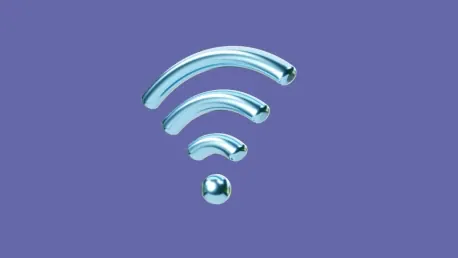In today’s fast-paced digital world, the demand for high-speed, reliable, and efficient wireless connectivity has never been more critical as we increasingly rely on multiple devices for work, entertainment, and communication. Enter Wi-Fi 7, also known as IEEE 802.11be Extremely High Throughput (EHT), which marks a significant milestone in the evolution of Wi-Fi technology. Designed to deliver unprecedented speeds, enhanced capacity, and superior reliability, Wi-Fi 7 is poised to transform how we connect to the internet and interact with our devices. This article explores the revolutionary features, advancements, and potential applications of Wi-Fi 7, shedding light on its anticipated impact across various environments.
A Leap in Speed and Capacity
Wi-Fi 7 represents a significant step up from its predecessors, Wi-Fi 6 and Wi-Fi 6E, by offering speeds that are over four times faster and network capacity that is five times greater. These improvements address the ever-growing demand for high-performance wireless connectivity in densely populated environments. Places like large public events, airports, and stadiums often face issues of interference and congestion due to the simultaneous operation of multiple devices. Wi-Fi 7’s advanced capabilities provide a solution to these challenges, ensuring seamless and efficient connectivity even in the most demanding scenarios.
One of the standout features of Wi-Fi 7 is its ability to operate over the newly allocated 6 GHz frequency band, in addition to the existing 2.4 GHz and 5 GHz bands. The inclusion of the 6 GHz band provides additional spectrum, resulting in less congested communication channels and overall enhanced performance. The increase in bandwidth capacity and reduction in latency makes Wi-Fi 7 an ideal solution for environments with high device density, providing faster data rates and more simultaneous data transmissions. This is especially beneficial in modern smart homes, offices, and industrial settings where multiple connected devices are the norm.
Enhanced Channel Size and Multi-Link Operation
Wi-Fi 7 achieves double the bandwidth capacity of Wi-Fi 6 by increasing the channel width from 160 MHz to 320 MHz. The width of a Wi-Fi channel is a crucial factor as it determines the volume of data that can be transmitted simultaneously. By widening the channels, Wi-Fi 7 ensures not only faster data rates but also facilitates more simultaneous data transmissions, leading to more efficient network usage and reduced latency. This capability is essential for streaming high-definition content, online gaming, and other bandwidth-intensive applications.
Another significant advancement introduced with Wi-Fi 7 is Multi-Link Operation (MLO). This feature enables the aggregation of multiple channels across any available frequency bands (6 GHz, 5 GHz, and 2.4 GHz). Devices employing MLO can send and receive data across different bands concurrently, resulting in lower latency and higher bandwidth. This innovation is particularly beneficial for applications requiring real-time responses and high data throughput, such as video conferencing, cloud computing, and extended reality gaming. MLO enhances the overall user experience by providing more stable and responsive connections, especially in environments with high network demand.
Advanced Modulation and MU-MIMO Technology
Wi-Fi 7 introduces an enhanced modulation technique known as 4096-QAM (Quadrature Amplitude Modulation), which packs more data into each transmitted signal, significantly boosting overall speed and efficiency. Compared to Wi-Fi 6’s 1024-QAM, the leap to 4096-QAM allows for a higher data encoding rate, which plays a critical role in environments with high-density device deployments. This advanced modulation ensures stable, reliable connectivity, maintaining performance even in the most challenging situations. Users can expect fewer disruptions and faster data transfers, which is essential for applications requiring uninterrupted connectivity.
Moreover, MU-MIMO (Multi-User Multiple Input, Multiple Output) technology receives a substantial upgrade with Wi-Fi 7. This technology allows a Wi-Fi router to communicate with multiple devices simultaneously. Wi-Fi 7 enhances this capability by increasing the number of spatial streams from 8 to 16, effectively doubling the transmission rate compared to Wi-Fi 6. The improvement in MU-MIMO facilitates better utilization of the available bandwidth, enhancing both individual and collective device performance. In practical terms, this means smoother video streaming, faster downloads, and an overall better experience for users with multiple connected devices.
Automated Frequency Coordination and Responsible Spectrum Use
Automated Frequency Coordination (AFC) plays a pivotal role in managing spectrum usage, especially within the 6 GHz band utilized by Wi-Fi 7. This coordination system maintains a comprehensive database of all bands in use by various RF services, such as weather radar systems and NASA communications, within a particular area. By checking this database, AFC helps Wi-Fi devices determine whether interference may occur and adjusts transmission power accordingly to avoid disrupting vital services. This feature is crucial for balancing technological advancements with the need for responsible and efficient spectrum management.
The implementation of AFC ensures optimal and responsible spectrum use while maintaining the integrity of essential services. This technology highlights the importance of responsible spectrum management, which is crucial for preserving the performance and reliability of services critical to various industries. By preventing interference with essential services, AFC enables Wi-Fi 7 networks to operate at their maximum potential while respecting the requirements of other spectrum users. This balance is vital for the continued growth and adoption of advanced wireless technologies in both consumer and professional settings.
Comparing Wi-Fi 7 with Wi-Fi 6 and Wi-Fi 6E
The advancements brought by Wi-Fi 7 are evident when compared to its immediate predecessors, Wi-Fi 6 and Wi-Fi 6E. Wi-Fi 7 achieves a theoretical maximum speed of 46 Gbps, significantly outperforming Wi-Fi 6’s 9.6 Gbps and Wi-Fi 6E’s 9.5 Gbps. This dramatic increase in speed underscores the technological strides made in this latest iteration. The enhanced performance enables faster data transfers, improved streaming quality, and more reliable connections in environments with numerous connected devices.
Wi-Fi 7 also supports channels up to 320 MHz, while Wi-Fi 6 and 6E support up to 160 MHz. The increased channel size allows for higher data throughput and reduced latency, translating to better performance in real-world applications. Additionally, Wi-Fi 7 can operate across a wider range of bands (6 GHz, 5 GHz, and 2.4 GHz), whereas Wi-Fi 6E also utilizes the 6 GHz band, providing a clear advantage over Wi-Fi 6. The transition from 1024-QAM to 4096-QAM in Wi-Fi 7 further underscores the efforts to enhance data encoding efficiency, leading to higher speeds and better performance in high-density environments. This makes Wi-Fi 7 particularly suitable for modern smart homes and offices.
Real-World Applications and Future Prospects
From homes and offices to public spaces and smart cities, Wi-Fi 7 aims to elevate the connectivity experience by delivering seamless performance, meeting the demands of modern digital life, and setting a new standard for wireless communication. This transformative technology is expected to play a pivotal role in enabling future innovations, supporting emerging applications, and integrating with other cutting-edge technologies such as 5G and IoT. The rapid adoption of Wi-Fi 7 will shape the future of wireless networks, providing a robust and scalable foundation for the next generation of digital connectivity.









